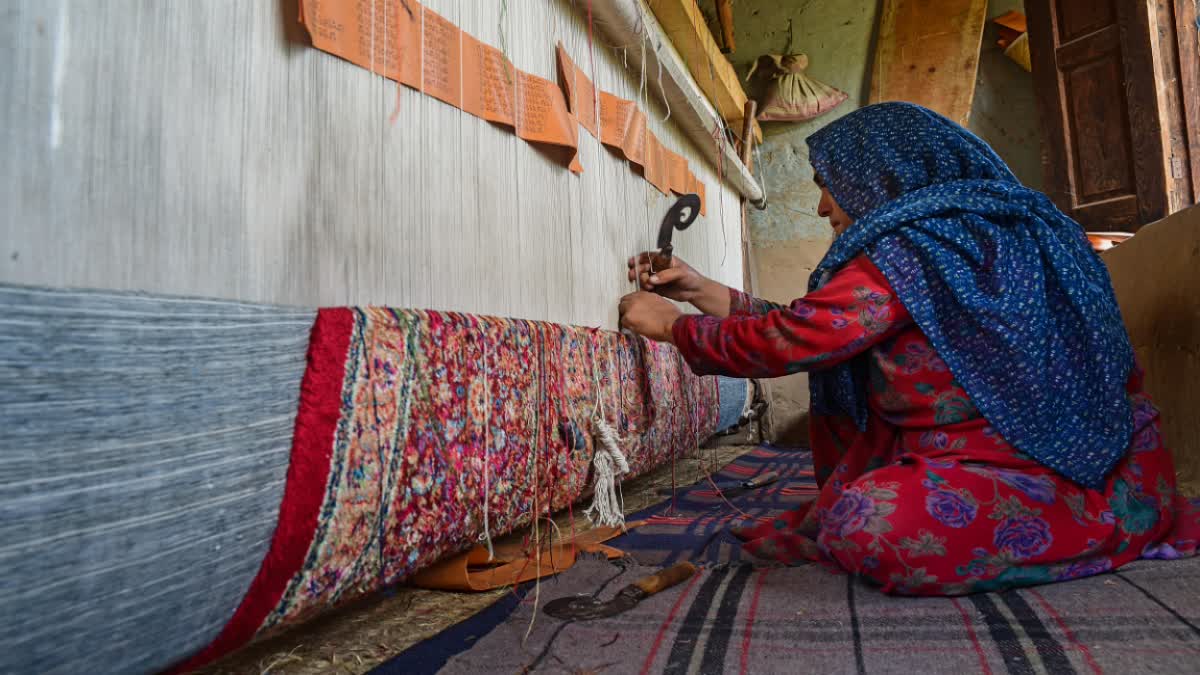Srinagar: Kashmir’s world-famous crafts industry is experiencing a sharp decline in exports as global conflicts reduce work orders for artisans. This situation resulted in an 80% drop in trade in the first three quarters of the previous fiscal year alone.
The ongoing wars, including those in Ukraine and Gaza, have affected thousands of artisans who are struggling to survive amid the crisis. More than 422,000 artisans are directly or indirectly associated with Kashmir’s handicraft trade, including 280,000 artisans registered with the government’s handicrafts and handlooms department. With the demand plummeting, the situation has forced many to abandon their trade to make ends meet.
The latest official estimates paint a grim picture after the initial signs of recovery after the COVID-19 pandemic. The last fiscal year has taken a downturn, with the export revenue standing at a mere Rs 208.18 crore for the first three quarters till November 2024, a staggering fall from Rs 1,162 crores from the previous annual trade.
For generations, artisans thrived on demand from big markets like Europe, West Asia, the United States of America (USA), and China, with the products gracing royal wardrobes and families. It is believed that French emperor Napoleon Bonaparte gifted his wife, empress Josephine, a Kashmiri handmade shawl, hence introducing the Valley’s exquisite textiles abroad. However, that demand has significantly dropped this year, with Director of the Handicrafts and Handlooms Department Mussarat Islam pointing to global conflicts like the Russia- Ukraine war and the Middle East for the sharp dip.

A weaver working on a traditional loom weaving an intricate carpet design in Kashmir (ETV Bharat)
A veteran in the industry like Mehboob Iqbal Shah, who is a co-founder of Artisane Art and Cultural Centre on the Srinagar-Gulmarg road, concedes that buyers from Europe and the USA, as well as Russia, are holding off on purchases because of the war.
In Russia, a major market for Kashmir’s handmade carpets, the demand has almost vanished, with the total volume of carpet trade falling to Rs 31.81 crore until November 2024. Official data shows that the carpet trade was the prime driver of the exports, touching Rs 821.50 crore in 2017 but falling to Rs 317 crore in 2023-24, with shawls (Rs 477.24 crore) leading the export revenue now.
“A single handmade carpet can sell for 100 times the price of a Pashmina shawl. But the orders have dried up, affecting the overall export revenue,” said Shah, whose family is well known for manufacturing handmade carpets.
Long before the war, machine-made carpets introduced illegally in the name of hand-knotted ones had hit artisans, forcing weavers to abandon carpet weaving and shift to more lucrative Kani weaving in the face of low wages and less demand.
High in demand, Kani weaving is similar to carpet weaving and uses a coded script (Taleem) to guide weavers in creating intricate designs. But for a well-known Kani weaving artisan like Majid Ahmad Mir from Srinagar, the decline in orders has affected them as well.
A national and state award craftsman, who holds a master’s in economics but chose to follow his forefathers into the trade, would employ 200 artisans, mainly women, across the Valley.
Srinagar received global acclaim last year after getting recognition as The World Craft City by the World Crafts Council (WCC), underscoring its rich heritage and the exceptional skills of its artisans. It followed Srinagar’s recognition as a United Nations Educational, Scientific and Cultural Organization (UNESCO) Creative City for Crafts in 2021.
“But today, many are without work due to few work orders,” Mir told ETV Bharat. “It is a luxury product, and it can thrive only in times of peace. Our long-time clients in Europe have shut down orders of scarves or stoles because the demand has significantly dropped. Without buyers, what are we supposed to do?”
Also Read
Machine-Made Turkish Carpets Sold As Kashmiri Hand-Knotted Ones, Govt Cracks Whip On SellersBehind The Music Of Rongali Bihu, Flute Makers Of Assam Village Struggle With Low Earning To Keep Tradition Alive
